
Juncaceae is a family of flowering plants, commonly known as the rush family. It consists of 8 genera and about 464 known species of slow-growing, rhizomatous, herbaceous monocotyledonous plants that may superficially resemble grasses and sedges. They often grow on infertile soils in a wide range of moisture conditions. The best-known and largest genus is Juncus. Most of the Juncus species grow exclusively in wetland habitats. A few rushes, such as Juncus bufonius are annuals, but most are perennials.

Juncus effusus, with the common names common rush or soft rush, is a perennial herbaceous flowering plant species in the rush family Juncaceae. In North America, the common name soft rush also refers to Juncus interior.

Juncus bufonius, known commonly as toad rush, is a widespread flowering plant species complex in the rush family Juncaceae.

Juncus articulatus is a flowering plant species in the rush family Juncaceae. It is known by the common name jointleaf rush or jointed rush, which can also refer to J. kraussii from Australia. It is native to Eurasia, Canada, Greenland, and much of the United States. It grows in moist areas, such as wet sand, and thrives in calcareous soils. J. articulatus was found to be more sensitive to drought and salt stress than its congeners J. acutus and J. maritimus. It is a perennial herb producing mainly erect stems from a short rhizome. The stem may root at nodes, and it generally has one or more flattened hollow cylindrical leaves up to 10 centimeters long. Transverse internal partitions or joints may be seen or felt in the leaf of the plant.
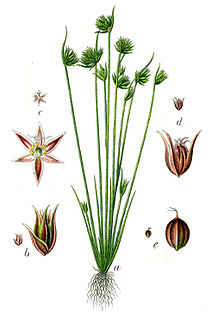
Juncus capitatus is a species of rush known by the common names dwarf rush and leafybract dwarf rush. It is native to Europe, Asia and North Africa. It is also an introduced species in parts of North America such as California and the Gulf Coast. It grows in moist areas, such as wet sand, vernal pools, and ditches.

Juncus patens is a species of rush, known by the common names spreading rush and California grey rush.

Juncus acuminatus is a species of rush known by the common names tapertip rush, tufted rush and sharp-fruited rush. It is native to North and Central America, where it can be found in and around water bodies from central Canada to Honduras. It is a rhizomatous perennial herb forming clumps up to about 80 centimeters tall. The inflorescence is an open array of many clusters of up to 20 flowers each. The flower has pointed segments a few millimeters long which may be light reddish brown to greenish in color.

Juncus bolanderi is a species of rush known by the common name Bolander's rush. It is native to western North America from British Columbia to northern California, where it grows in many types of wet habitat, such as marshes, beaches, and meadows. It is a rhizomatous perennial herb forming bunches of smooth stems up to about 80 centimeters long. The inflorescence is made up of one or more clusters of many tiny flowers accompanied by one long bract. Each flower has brown, pointed segments each about 3 millimeters long.

Juncus covillei is a species of rush known by the common name Coville's rush native to North America.
Juncus kelloggii is a species of rush known by the common name Kellogg's dwarf rush.
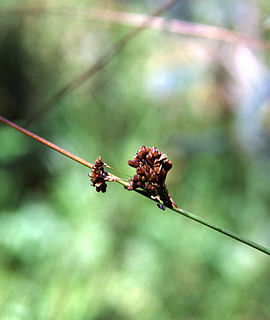
Juncus lesueurii is a species of rush known by the common names Lesueur's rush and salt rush. It is accepted by some authorities as Juncus lescurii.

Juncus longistylis is a species of rush known by the common name longstyle rush. It is native to much of North America, including most of the United States and the southern Canadian provinces. It grows in moist terrestrial habitat, such as mountain meadows. It is a rhizomatous perennial herb forming clumps of slender stems up to about 60 centimeters tall. The inflorescence is made up of one to nine clusters of a few tiny flowers each. The flower is made up of several segments which are green with translucent margins.
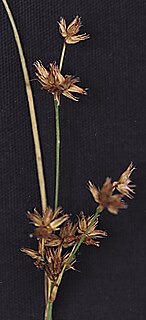
Juncus nodosus is a species of rush known by the common name knotted rush. It is native to much of North America from northern Canada to central Mexico, where it grows in wet places from freshwater to salt marsh habitat. This is a rhizomatous perennial herb producing slender, smooth stems up to about 60 centimeters tall. The inflorescence is a series of spherical clusters of flowers. Each flower has green or brown pointed segments each a few millimeters long and tapering to a point.

Juncus orthophyllus is a species of rush known by the common name straightleaf rush native to western North America from British Columbia to California and Nevada, where it grows in moist spots in mountain habitat, such as meadows.
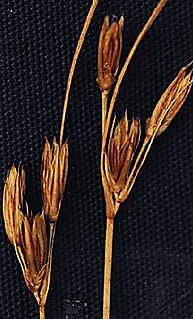
Juncus parryi is a species of rush known by the common name Parry's rush. It is native to western North America from British Columbia and Alberta to California to Colorado, where it grows in moist and dry spots in mountain habitat, including rocky talus and other areas in the subalpine and alpine climate. This is a rhizomatous perennial herb producing a dense clump of stems up to about 30 centimeters tall. There are short, thready leaves around the stem bases. The inflorescence is a cluster of flowers accompanied by a long, cylindrical bract which appears like an extension of the stem. The flower is made up of a few pointed, brown segments with membranous edges.
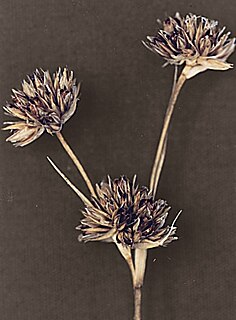
Juncus regelii is a species of rush known by the common name Regel's rush. It is native to western North America from British Columbia to Utah, where it grows in moist mountainous habitat, such as meadows. This is a rhizomatous perennial herb producing a dense clump of flattened stems up to about 60 centimeters tall. The inflorescence is made up of one or more thin or dense clusters of up to 30 flowers each. The flower has narrow, pointed brown to greenish segments.
Juncus triformis is an uncommon species of rush known by the common names Yosemite dwarf rush and long-styled dwarf rush.

Juncus acutiflorus, also called sharp-flowered rush, is a rush or a grassy plant of the genus Juncus. As the name suggests, the plant has notable sharp-looking flowers, flowering between July and September.
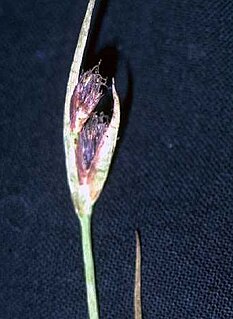
Juncus castaneus is a species of rush known by the common name chestnut rush. It has a circumboreal or circumpolar distribution, occurring throughout the northern latitudes of the Northern Hemisphere. It occurs in Europe, Asia, and North America. In North America it occurs from Alaska to Greenland, its distribution spanning Canada and extending south through the Rocky Mountains in the contiguous United States. It is widespread and common in the Canadian Arctic Archipelago.

Oreojuncus trifidus is a species of rush known by the common names highland rush and three-leaved rush. It is native to the Northern Hemisphere, where it is an arctic/montane species with an amphi-atlantic distribution.

















